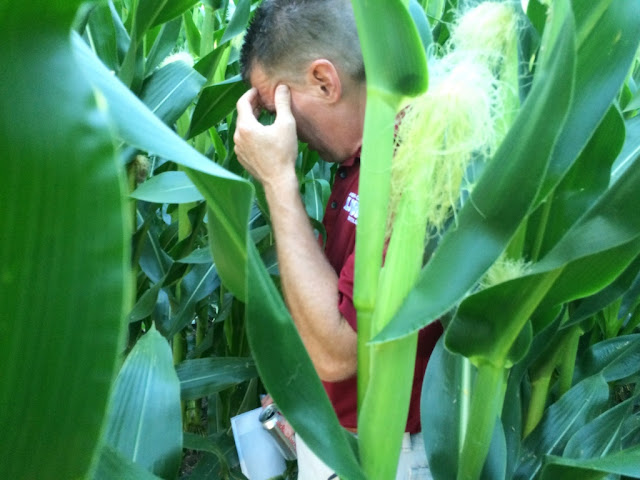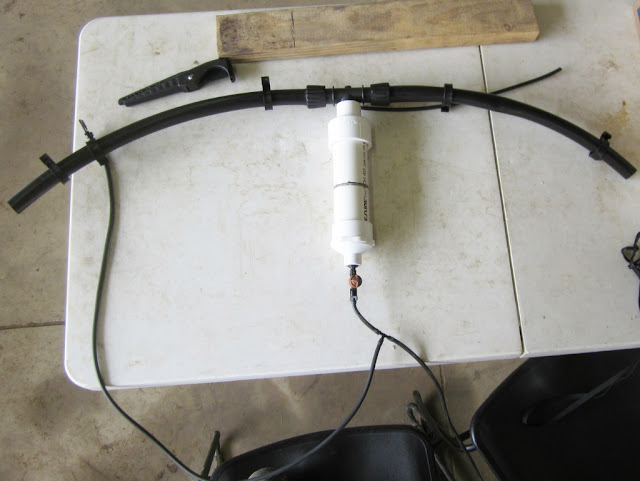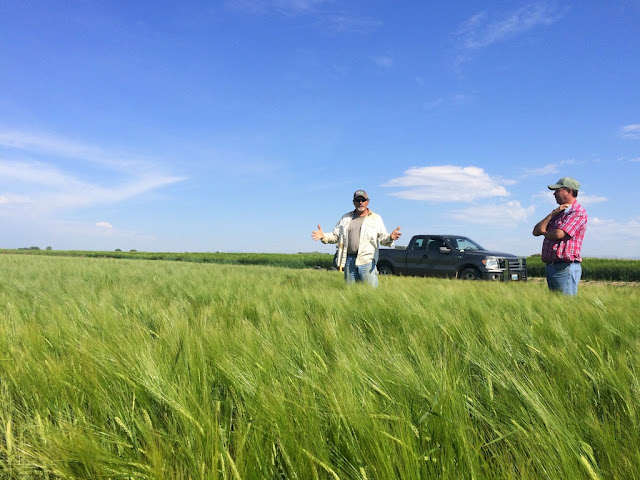So last week I was in Wyoming to visit with some growers that I have known for some time, working with AgroLiquid field salesman Alan Lebsack and RSM/SAM Stuart (don't ask). We were down in SE Wyoming the first day. Several growers in the area have been using only AgroLiquid for a number of years and the crops look great. One advantage they have here is water. Mother Nature provided ample rainfall this spring, and they have not yet needed to irrigate. But it is time to give a drink now. However, thirsty corn here is having to wait until the irrigation canals get unclogged from debris washed in from the rains. What a revolting development this is. You can also see alfalfa bales to the left that were fertilized with Liquid. Well I mean the alfalfa that went into the bales was.

Wonder if your fertilizer is doing anything? Well leave off the fertilizer pump switch for a check plot. And if you do it accidentally, tell everyone it is a controlled experiment. Works for me. I have shown this grower's planting equipment in the past where he runs a Schlagel strip till unit with a planter attached in the same unit. Talk about doubling up operations. He runs Liquid fertilizer through both. The Schlagel manufacturing plant is in nearby Torrington.
This being basically desert soils with high pH, occasionally there can be outcroppings of high sodium soil as seen in this picture in a field of another grower. It can be corrected with applications of elemental sulfur and gypsum, but it takes time. However he indicated in the two years of using AgroLiquid, the spots are getting smaller and the plants are better in them. Interesting how good rows can be so close to problem rows. He is collecting soil from the good and the bad spots for a soil test to monitor conditions.
The next day we met with Chris Cook, seen below talking to some skinny guy named Stuart and salesman Alan. You can tell Alan is a salesman since he's on the phone.

Chris showed us a plot at the James C. Hageman Sustainable Agriculture Research and Extension Center near Lingle, WY. (With a name that long, they must be doing something important there.) Anyway, Chris farms practically right next door and encouraged them to try some AgroLiquid in a test plot. Strip till is big in the area, but they were without one, so Chris made these applications for them. On the left is 20 gal/A of High NRG-N placed 4" beneath the soil surface, or around 2" beneath the seed. On the right is 29 gal/A of 32% UAN. So it is 58 lb-N vs 101 lb-N. So how come the High NRG-N side looks taller and greener? Another mystery of the plains. Yield will tell the whole story, and there is more N yet to put on at side-dress. Unfortunately they were having planter problems at the station, so no other fertilizer was applied.

Over to Chris's fields. They all looked very good. He runs High NRG-N through the strip till and then Pro-Germinator + Sure-K + Micro 500 + eNhance + Boron through the planter in furrow. Then more High NRG-N at sidedress.
Oh did I mention that Chris has won the Wyoming Corn Growers Yield contest for Strip Till the past two years? Well he did. Last year his contest plot yielded 262 bu/A. I'll look for higher yields this year as good as it looks now.

Irrigation is critical here. This is pretty much a desert. As mentioned they had good rain this spring though. Chris mostly furrow irrigates, but also has corn under a pivot. Like many growers still, he did once only run water every other furrow. But it was seen that in particularly dry years, the roots did not grow into the dry side. So since then, he runs water in all furrows. However, the supply allotment is not enough to water all furrows at the same time. So he waters every other furrow eight hours at a time. Then he physically has to close the gates on those furrows and re-open them on the other rows every eight hours. What a lot of work, but the rewards are plenty. You can see the water flowing down the furrow in the middle while the others on either side are wet from being watered earlier.

Pinto beans are also a big crop in the area. He runs some High NRG-N + accesS through the strip till and then 2.5 gal/A of Pro-Germinator + 2 qt/A Micro 500 in furrow with the planter. (Is it just me or does it look like the row spacing gets narrower as you go down the field. Should have walked down and measured.)
And Chris also grows high yielding alfalfa, like here in field 7. (They have an interesting way of marking fields, don't they?) Here they foliar apply Pro-Germinator + Sure-K + Micro 500, Boron and accesS.
Sure is pretty country and glad that things are looking so good. Why shouldn't they? Hard work and good crop nutrition go a long ways out here. Thanks for the tour Chris.


















































